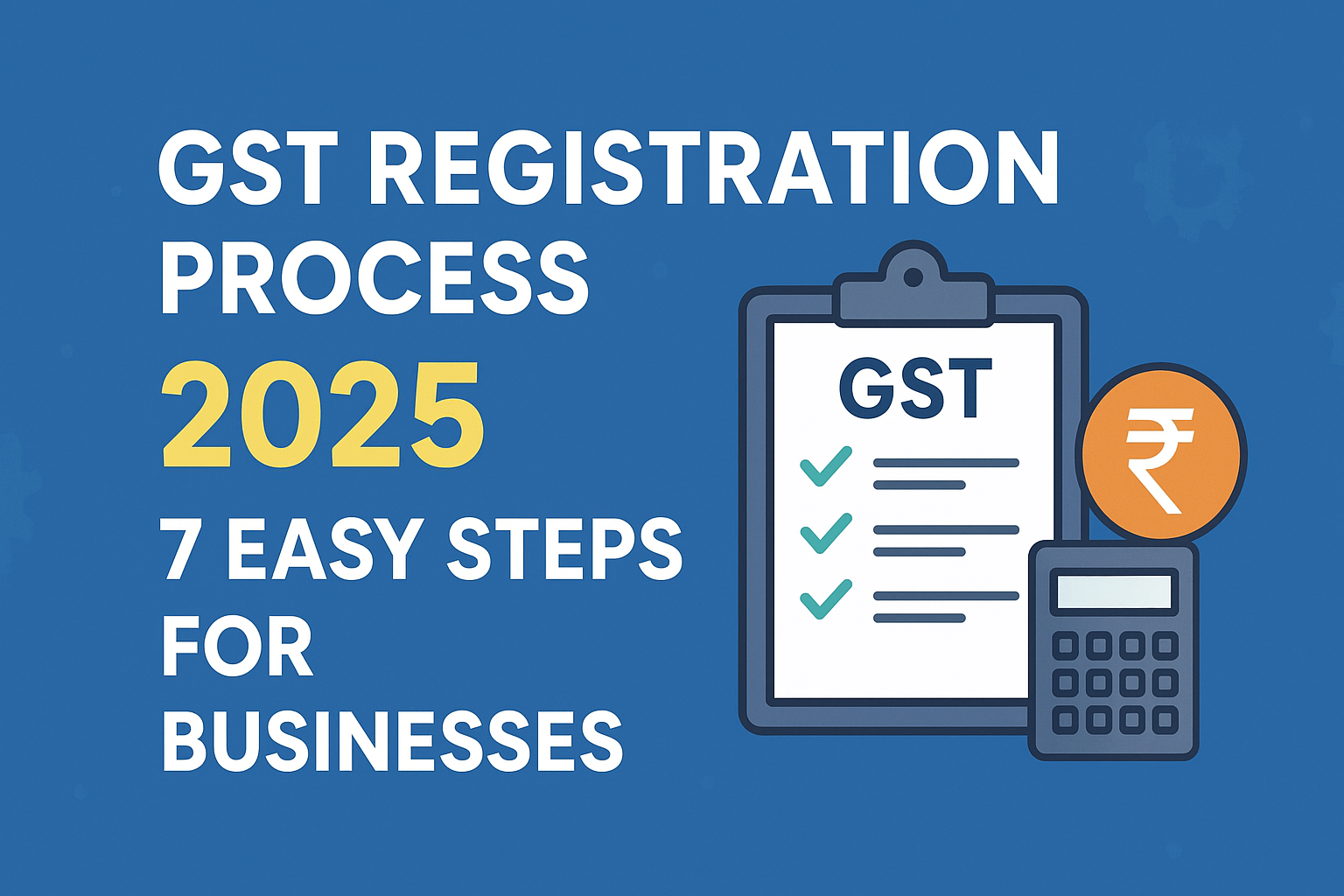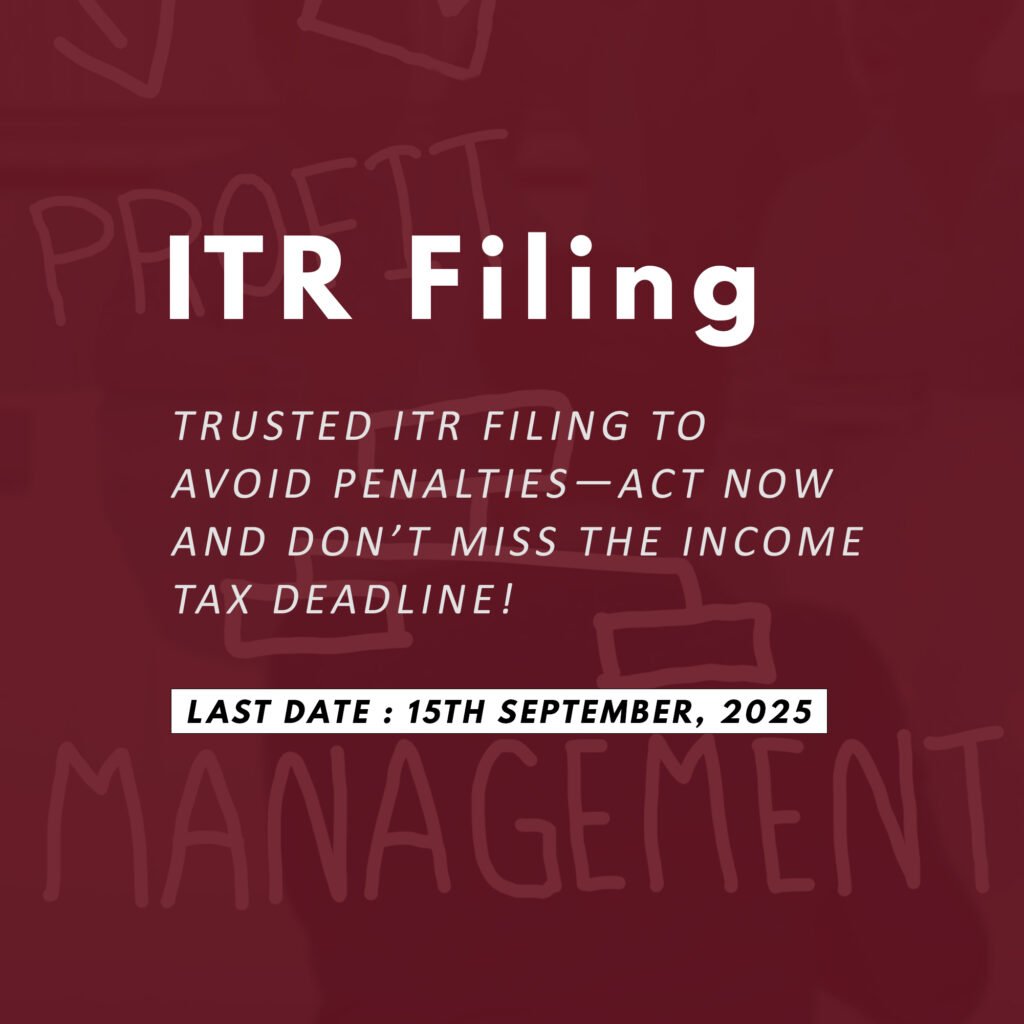GST Registration Process in India (2025): Step-by-Step Guide for Businesses
Goods and Services Tax (GST) has become the backbone of India’s indirect tax system. Every business owner who crosses the turnover threshold—or falls under mandatory registration rules—must complete the GST registration process. Having a valid GSTIN (Goods and Services Tax Identification Number) not only ensures compliance but also builds credibility and helps businesses expand without restrictions.
In this blog, we’ll explain the entire GST registration process in India (2025), including eligibility, documents required, step-by-step application, fees, and key mistakes to avoid.

What is GST Registration Process?
GST registration is the legal process by which a business or professional enrolls under the GST law and obtains a unique 15-digit GSTIN. This number is issued by the GST authorities and is mandatory for businesses that:
- Exceed the turnover threshold (₹40 lakh for goods, ₹20 lakh for services, lower limits in some states).
- Make interstate supply of goods or services.
- Operate as an e-commerce seller or aggregator.
- Are required to pay tax under the reverse charge mechanism.
👉 Without GST registration, businesses cannot legally collect GST or claim Input Tax Credit (ITC).
Who Needs GST Registration?
You must register for GST if you are:
- A business with turnover exceeding the threshold limit (₹40 lakh/₹20 lakh/₹10 lakh based on state and nature of supply).
- Casual taxable person or Non-Resident taxable person.
- Agent supplying goods/services on behalf of others.
- Input Service Distributor (ISD).
- E-commerce operator collecting TCS under GST.
- Government body required to deduct TDS under GST.
- Online service providers (like gaming or software) supplying to Indian customers.
Benefits of GST Registration
- Legal Authorization to Collect Tax – Only registered businesses can charge GST from customers.
- Eligibility for Input Tax Credit (ITC) – Claim back the GST paid on purchases.
- Expansion Beyond State Borders – Interstate trade becomes easier.
- E-commerce Compliance – Sell on platforms like Amazon, Flipkart, etc.
- Better Business Credibility – GSTIN builds trust with vendors, banks, and customers.
Documents Required for GST Registration
Here’s the checklist of documents you’ll need:
- PAN card of the business or applicant
- Aadhaar card of proprietor/partners/directors
- Business registration proof (Incorporation Certificate/Partnership deed)
- Address proof of business premises (rent agreement, electricity bill, property tax receipt)
- Bank account details (bank statement or canceled cheque)
- Photographs of proprietors/partners/directors
- Digital Signature Certificate (DSC) for companies/LLPs
- Letter of Authorization/Board Resolution for authorized signatory
Step-by-Step GST Registration Process (2025)
Here’s a complete breakdown of the registration process:
Step 1: Visit GST Portal
Go to the official GST portal and click on “Register Now” under the Services tab.
Step 2: Fill Part A of Form GST REG-01
- Enter details like PAN, mobile number, and email ID.
- Validate with OTP.
- Temporary Reference Number (TRN) is generated.
Step 3: Fill Part B of Form GST REG-01
- Login with TRN.
- Provide business details, promoter information, principal place of business, additional places, and bank details.
- Upload supporting documents.
Step 4: Verification
- Application is verified through Aadhaar authentication.
- In some cases, physical verification of premises may be required.
Step 5: GSTIN Allotment
- Once approved, a 15-digit GSTIN is issued.
- The taxpayer can download the GST Registration Certificate (Form GST REG-06).
Timeframe for GST Registration
Typically, GST registration is processed within 2–6 working days, provided documents are in order. If authorities raise queries, it may take longer.
Fees for GST Registration
- No government fee is charged for GST registration on the GST portal.
- However, businesses may choose to hire tax professionals or consultants for faster processing, which involves service charges.
GST Registration Certificate
The GST registration certificate is issued online and contains:
- Legal and trade name of the business
- GSTIN
- Constitution of business (Proprietorship, Partnership, Company, etc.)
- Address of principal and additional places of business
- Date of registration
- Jurisdictional officer details
Penalty for Not Registering Under GST
Failure to register when required can lead to heavy penalties:
- 10% of the tax amount due (minimum ₹10,000) for genuine mistakes.
- 100% of the tax amount due if tax evasion is proven.
Penalty for Not Registering Under GST
- ❌ Using incorrect PAN details.
- ❌ Uploading blurred or mismatched documents.
- ❌ Entering wrong address or bank details.
- ❌ Ignoring Aadhaar authentication.
- ❌ Not responding to queries from GST officers within the deadline.
Expert Tips for Smooth GST Registration
- ✅ Keep all documents scanned and ready in PDF/JPEG format.
- ✅ Use the same mobile and email ID consistently for OTP verifications.
- ✅ Double-check bank account details to avoid rejection.
- ✅ Track application status regularly using TRN.
- ✅ Consult a GST expert if you face repeated queries or rejections.
Final Thoughts
The GST registration process in India (2025) is straightforward if you keep documents ready and follow the steps carefully. For most businesses, GST registration is not just a compliance requirement but also a gateway to new opportunities—whether that’s interstate trade, e-commerce sales, or claiming valuable Input Tax Credit.
By registering under GST on time, you save yourself from penalties, gain legal recognition, and build stronger business credibility.
At The Advise Brain, we’re committed to simplifying taxation and compliance for Indian businesses. Stay tuned for more guides on GST filing, ITC rules, and business law essentials.
FAQ
1. What is GST registration, and why is it required in India?
GST registration is the legal process of enrolling a business under Goods and Services Tax law to obtain a unique GSTIN. It is required to collect GST, claim Input Tax Credit, and operate legally across India.
2. Who is eligible for GST registration in India (2025)?
Businesses with turnover above ₹40 lakh (for goods) or ₹20 lakh (for services) must register. Certain cases, like interstate supply, e-commerce sellers, and non-resident taxpayers, also require mandatory registration.
3. What documents are required for GST registration?
Key documents include PAN card, Aadhaar card, business proof, address proof of premises, bank details, photographs of owners/directors, and a Digital Signature Certificate (for companies/LLPs).
4. How to apply for GST registration online?
You can register online via the GST portal by filling out Form GST REG-01 in two parts, uploading documents, completing Aadhaar verification, and receiving a GSTIN after approval.
5. How much time does GST registration take in India?
Typically, GST registration takes 2–6 working days if documents are correct. Delays may occur if authorities raise queries or require physical verification.
6. Is there any government fee for GST registration?
No, GST registration is completely free on the official GST portal. However, businesses may choose to pay professional service charges if they hire consultants.
7. What are the benefits of GST registration for businesses?
Benefits include legal authorization to collect tax, claiming Input Tax Credit, easier interstate trade, compliance for e-commerce platforms, and enhanced credibility with banks, vendors, and customers.
8. What is the penalty for not registering under GST?
If a business fails to register, penalties can be 10% of the tax amount (minimum ₹10,000) for genuine cases, or 100% of the tax amount if tax evasion is detected.
9. How can I download my GST registration certificate?
After approval, the GST registration certificate (Form GST REG-06) can be downloaded from the GST portal. It must be displayed at the principal business premises.
10. What mistakes should be avoided during GST registration?
Common mistakes include incorrect PAN, mismatched documents, wrong address or bank details, skipping Aadhaar authentication, and not replying to GST officer queries on time.

